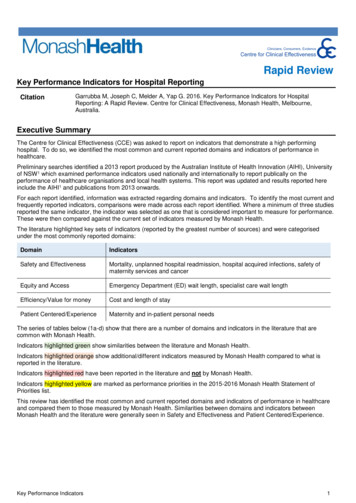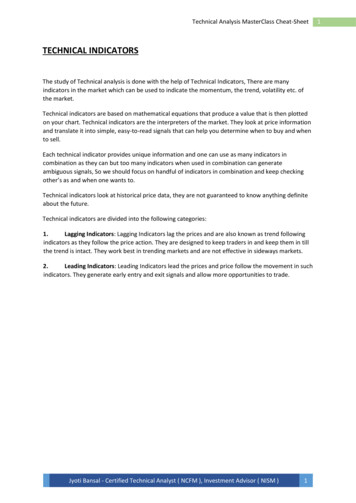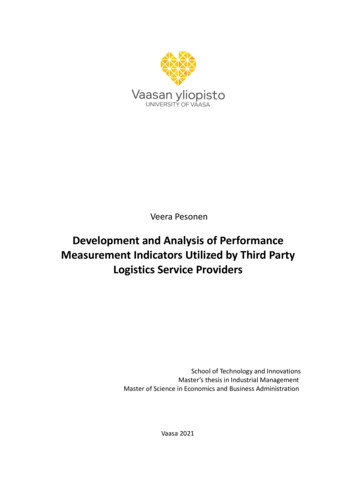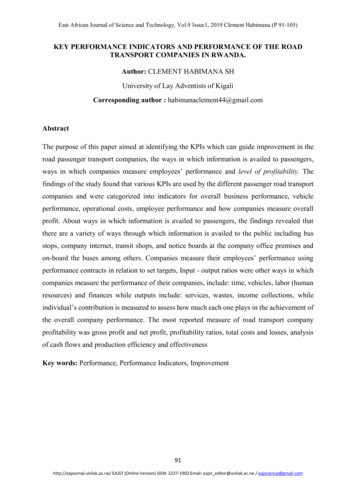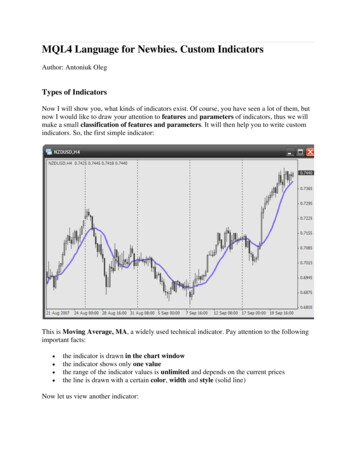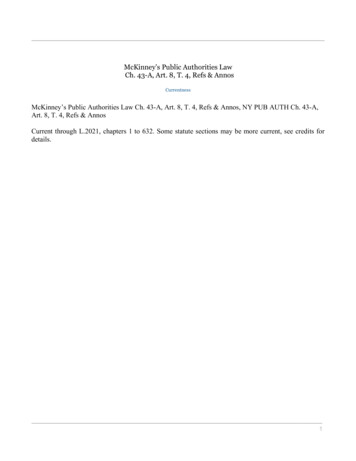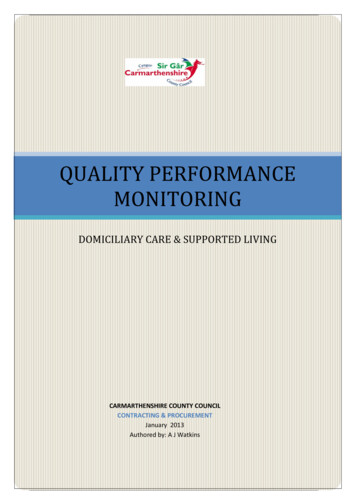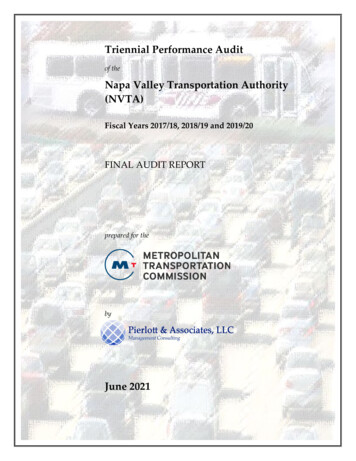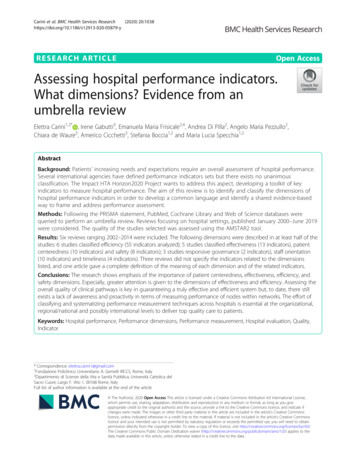
Transcription
Carini et al. BMC Health Services Research(2020) ESEARCH ARTICLEOpen AccessAssessing hospital performance indicators.What dimensions? Evidence from anumbrella reviewElettra Carini1,2* , Irene Gabutti3, Emanuela Maria Frisicale2,4, Andrea Di Pilla2, Angelo Maria Pezzullo2,Chiara de Waure5, Americo Cicchetti3, Stefania Boccia1,2 and Maria Lucia Specchia1,2AbstractBackground: Patients’ increasing needs and expectations require an overall assessment of hospital performance.Several international agencies have defined performance indicators sets but there exists no unanimousclassification. The Impact HTA Horizon2020 Project wants to address this aspect, developing a toolkit of keyindicators to measure hospital performance. The aim of this review is to identify and classify the dimensions ofhospital performance indicators in order to develop a common language and identify a shared evidence-basedway to frame and address performance assessment.Methods: Following the PRISMA statement, PubMed, Cochrane Library and Web of Science databases werequeried to perform an umbrella review. Reviews focusing on hospital settings, published January 2000–June 2019were considered. The quality of the studies selected was assessed using the AMSTAR2 tool.Results: Six reviews ranging 2002–2014 were included. The following dimensions were described in at least half of thestudies: 6 studies classified efficiency (55 indicators analyzed); 5 studies classified effectiveness (13 indicators), patientcenteredness (10 indicators) and safety (8 indicators); 3 studies responsive governance (2 indicators), staff orientation(10 indicators) and timeliness (4 indicators). Three reviews did not specify the indicators related to the dimensionslisted, and one article gave a complete definition of the meaning of each dimension and of the related indicators.Conclusions: The research shows emphasis of the importance of patient centeredness, effectiveness, efficiency, andsafety dimensions. Especially, greater attention is given to the dimensions of effectiveness and efficiency. Assessing theoverall quality of clinical pathways is key in guaranteeing a truly effective and efficient system but, to date, there stillexists a lack of awareness and proactivity in terms of measuring performance of nodes within networks. The effort ofclassifying and systematizing performance measurement techniques across hospitals is essential at the organizational,regional/national and possibly international levels to deliver top quality care to patients.Keywords: Hospital performance, Performance dimensions, Performance measurement, Hospital evaluation, Quality,Indicator* Correspondence: elettra.carini1@gmail.com1Fondazione Policlinico Universitario A. Gemelli IRCCS, Rome, Italy2Dipartimento di Scienze della Vita e Sanità Pubblica, Università Cattolica delSacro Cuore, Largo F. Vito 1, 00168 Rome, ItalyFull list of author information is available at the end of the article The Author(s). 2020 Open Access This article is licensed under a Creative Commons Attribution 4.0 International License,which permits use, sharing, adaptation, distribution and reproduction in any medium or format, as long as you giveappropriate credit to the original author(s) and the source, provide a link to the Creative Commons licence, and indicate ifchanges were made. The images or other third party material in this article are included in the article's Creative Commonslicence, unless indicated otherwise in a credit line to the material. If material is not included in the article's Creative Commonslicence and your intended use is not permitted by statutory regulation or exceeds the permitted use, you will need to obtainpermission directly from the copyright holder. To view a copy of this licence, visit http://creativecommons.org/licenses/by/4.0/.The Creative Commons Public Domain Dedication waiver ) applies to thedata made available in this article, unless otherwise stated in a credit line to the data.
Carini et al. BMC Health Services Research(2020) 20:1038BackgroundAddressing issues related to quality of care is one of themajor concerns of healthcare systems [1]. It is a current topicon the agenda of policy makers at different levels and worldwide [2] because of a growing need to control costs andguarantee sustainability, reduce variability in healthcare delivery, ensure transparency and accountability, deliver effective,safe and person-centered care, improve patients’ clinical outcomes and their satisfaction [2, 4].Scientific literature on the topic is wide and evidence isavailable on different aspects of quality of care. These leadto several perspectives such as, for example, area or levelof care, type of organization, improvement strategies [2].Despite the broad literature, disagreement persists onwhat the expression “quality of care” comprehends andthere is no unanimous understanding of the term [2]. Thedefinition of Donabedian, who defines quality as “the ability to achieve desirable objectives using legitimate means”,is perhaps the one that better describes the concept inhealthcare [2]. Also, according to Donabedian, quality ofcare is referred to the whole process of care, where thegoal is to maximize general patient welfare and health outcomes [2]. The internationally accepted definition of theInstitute of Medicine also recalls health outcomes andgives importance to evidence and professional knowledge[5]. Moreover, this last definition and the one formulatedby World Health Organization (WHO) in 2006 [5] encompass other characteristics of care delivery. Healthcarehas to be safe, effective, patient-centered, timely, efficient,equitable, acceptable and accessible. Among these features, safety, effectiveness and patient-centeredness/responsiveness can be considered universally as coredimensions while others can be viewed as subdimensions[2]. This distinction is based on the framework (HealthCare Quality Indicator (HCQI) project) formulated by theOrganization for Economic Co-operation and Development (OECD) in 2006 with the intent to lead the development of indicators in order to compare quality at theinternational level [2]. Indicators are indirect measuresthat provide information about the dimensions of qualityof care [2]. Measurement is important to assess qualityand implement improvement actions in order to providebetter healthcare and enhance health outcomes. The useof standardized indicators leads on one hand to a betterassessment across all levels of healthcare, on the other, tothe increase of transparency and trust by patients [5].Quality is not a synonym of performance but it is an important component of healthcare systems’ performance.This latter concept is therefore wider than the one ofquality and describes the extent to which health systemsare able to reach their goals [2].Monitoring healthcare providers’ performance is relevant worldwide, especially in settings such as hospitals,given their significant weight in terms of both healthPage 2 of 13and economic effects. In 2003, WHO launched a projectaimed at supporting hospitals in order to develop aframework for the assessment of their performance. Theproject – named PATH (Performance Assessment Toolfor quality improvement in Hospital) – was aimed atidentifying dimensions and indicators for assessing hospital performance [4]. However, despite the detection ofa great number of hospital performance indicators, somegaps in their measurement as well as issues concerningthe dimensions investigated still exist. For example,some dimensions are under-represented and somehealthcare settings or clinical specialties are not welltracked [6].This study is part of the IMPACT HTA (ImprovedMethods and ACtionable Tools for enhancing HTA)project. IMPACT HTA is a Horizon 2020 research project aimed at studying variations in costs and health outcomes and at improving economic evaluation regardingHTA (Health Technology Assessment) and health system performance measurement through the integrationof clinical and economic data from different sources.The measurement of hospital performance and its linkwith organizational models is one of the core aspects ofthe project. Within the latter, the authors of this paperdealt with the identification and classification of the dimensions of hospital performance indicators, accordingto scientific evidence, with the double aim of synthesizing the available knowledge on the topic in a comprehensive manner and providing the basis for a possiblecommon way of measuring hospital performance.MethodsAn umbrella review was performed with the aim of aggregating findings from reviews available on the topic.Indeed, an umbrella review allows to aggregate findingsfrom reviews, making it possible to reassemble the fragmented knowledge concerning a specific topic. In otherwords, it provides a synthesis of the evidence describedin several reviews that has been conducted on the sametopic [7, 8].Search strategyTo perform an umbrella review, PubMed, Cochrane Library, and Web of Science databases were queriedthrough the following search string: ((((Indicator* ORstandard OR benchmark*) AND (project* OR programOR tool* OR set OR model)) AND ((outcome OR output) OR (quality OR effectiveness OR safety OR appropriateness OR efficiency OR “patient satisfaction” ORefficacy OR equity OR accountability OR “patientcentredness” OR “patient centeredness” OR “staff orientation” OR “staff satisfaction” OR access*))) AND (measure* OR assess* OR evaluate OR implement*)) AND(performance AND “hospital*”). The investigation was
Carini et al. BMC Health Services Research(2020) 20:1038conducted in June 2019 and the articles retrieved werescreened according to the inclusion/exclusion criteriapreviously stated and listed in the following paragraph.Inclusion/exclusion criteriaThe selection of the articles was conducted referring topreviously defined inclusion and exclusion criteria. Onlyreview articles focused on indicators of hospital performance, written in English or Italian, ranging fromJanuary 1st, 2000 to June 30th, 2019 and available in fulltext were considered. The included reviews had to classify the dimensions of hospital performance; articles analyzing only one dimension were maintained. Articlesexamining single indicators or lacking a classification indimensions or reporting a classification only related to asingle clinical setting or specialty were excluded.Data synthesisThe selection of the articles followed the PRISMA statement [9]. Two researchers screened independently the results by title and abstract and finally by full text. Eventualdisagreements were discussed between the researchers inorder to find a solution and in case of persistent discordance a third researcher was involved in the decision. Tosynthetize the selected articles, a table was designed andthe following information were extracted: authors, country, year of publication, title, objective, results, dimension/subdimension, indicators, definition of each indicator. Aqualitative synthesis was performed to analyze the data. Aquantitative synthesis was not carried out due to the heterogeneity of the data retrieved.Quality appraisalThe quality of the studies selected was assessed usingAMSTAR2 (A MeaSurement Tool to Assess systematicReviews). AMSTAR2 allows to evaluate different aspectsof reviews in order to define the quality of the studies. Itenables researchers to carry out rapid and reproducibleassessments to evaluate the published version of a review. The tool is composed of 16 domains in the formof questions that can be answered with ‘yes’; ‘partial yes’or ‘no’. Seven out of 16 are the domains which can critically affect the validity of the review (in particular, domains 2, 4, 7, 9, 11, 13, and 15). The review is finallyrated with a high, moderate, low or critically low overallconfidence [10].ReportingThe whole document has been produced bearing inmind the PRISMA statement indications [9].ResultsFrom the search, 222 records were identified in Web ofScience, 333 in PubMed and 211 in Cochrane LibraryPage 3 of 13(Fig. 1). Duplicates removing was conducted throughMendeley software and a total number of 682 recordswas subsequently screened. A spreadsheet was compiledand, carefully reading the titles, 64 studies were assessedfor eligibility. Six reviews were finally included in thequalitative synthesis.The six reviews retrieved range from 2002 to 2014.Their main characteristics and results are summarizedin Table 1. All the studies report a classification of theindicators in diverse dimensions but not all of them specify the indicators included in each. The ones only describing the dimensions are three [1, 3, 6]. The reviewby Veillard et al. gives a deeper insight providing a definition of the dimensions and a precise definition of eachindicator described [4]. A subclassification of the dimensions is proposed by two reviews: Ganjour et al. groupthe indicators according to the disease or interventionthey refer to [11], while Veillard et al. specify each dimension according to specific and detailed characteristics [4].The dimensions of performance indicatorsThe dimensions in which the indicators of hospital performance have been classified are (Fig. 2): efficiency (6 studies;100%) [1, 3, 4, 6, 11, 12], clinical effectiveness (5 studies;83%) [1, 3, 4, 6, 12], patient-centeredness (5 studies; 83%) [1,3, 4, 6, 12], safety (5 studies; 83%) [1, 3, 4, 6, 12], responsivegovernance (3 studies; 50%) [1, 3, 4], staff orientation (3 studies; 50%) [1, 3, 12], timeliness (3 studies; 50%) [1, 6, 12],equity (2 studies; 33%) [1, 6], utilization (2 studies; 33%) [1,12]. All the other dimensions were described by only 1 (17%)article: acceptability [1], accessibility [1], appropriateness [1],care environment and amenities [1], continuity [1], competence or capability [1], expenditure or cost [1], improvinghealth or clinical focus [1], resources and capacity [12], andsustainability [1]. The main findings of this work are summarized in the following paragraphs, while detailed informationis presented in Table 2.EfficiencyEfficiency has been explored by all the reviews included[1, 3, 4, 6, 11, 12]. It can be defined as the optimal allocation of available healthcare resources that maximizehealth outcomes for society [13]. Veillard et al. similarlyrefer to efficiency as hospital optimal use of inputs toyield maximal outputs, given the available resources [4].The review by Gandjour et al. considers efficiency interms of process (referring to specific clinical conditions)and structure [11]. Veillard et al. also provide a subclassification of the dimension, describing efficiency in termsof appropriateness of services, productivity, and use ofcapacity [4].
Carini et al. BMC Health Services Research(2020) 20:1038Page 4 of 13Fig. 1 Flowchart depicting literature search and study selectionClinical effectivenessAccording to Veillard et al., clinical effectiveness is theappropriateness and competence which allows to deliverclinical care and services with the maximum benefit forall patients [4]. This study sub-classifies this dimensionin appropriateness of care, conformity of processes ofcare, and outcomes of care and safety processes [4].Simou et al., take into account mortality rates, readmissions, and survival [12].families’ orientations. The main aim is to evaluatewhether patients are placed at the center of care and service delivery [4]. Simou et al. provide patient centeredness indicators in terms of patients’ feedback [12].SafetySafety refers both to patients and professionals in terms ofthe ability to avoid, prevent and reduce harmful interventions or risks for them and for the environment [4, 12].Patient-centerednessResponsive governanceAs reported by Veillard et al., this dimension concerns aset of indicators which pay attention to patients’ andAnother aspect analyzed by three out of the six reviewsis responsive governance [1, 3, 4]. Veillard et al. provide
Carini et al. BMC Health Services Research(2020) 20:1038Page 5 of 13Table 1 Characteristics of the reviews included1st author,Year,CountryDatabases TitleDaterangeObjectiveGandjour A,2002 [11](Germany)PubMedUp to July2000An Evidence-Based Evaluation To identify and appraise quality andof Quality and Efficiencyefficiency indicators relevant to hospitals orIndicators.physicians’ practices.Veillard J,2005 [4](Spain,Canada, TheNetherlands,USA)PubMedWeb OfScience2003–2005A performance assessmentframework for hospitals: theWHO regional office forEurope PATH project.Groene O,2008 [3](Spain,Denmark)Main resultsSeven structural indicators and 34 processindicators were identified and appraised.The set of performance indicators couldserve as a state-of-the-art system of measurement for governments and organizations evaluating the quality and efficiencyof healthcare.To describe the first step of PATH project:to develop an overall framework forhospital performance assessment.Six dimensions were identified: clinicaleffectiveness (3 subdimensions:appropriateness of care, conformity ofprocesses of care, n outcomes of care andsafety processes for a total number of 7indicators), safety (2 indicators), patientcenteredness (5 indicators), productionefficiency (3 subdimensions:appropriateness of services, productivity,use of capacity for a total of 4 indicators),staff orientation (3 subdimensions:perspective and recognition of individualneeds, health promotion and safetyinitiatives, behavioral response for a total of4 indicators) and responsive governance (2subdimensions: system integration andcontinuity, public health orientation with 1indicator each).PubMedAn international review ofWeb Ofprojects on hospitalScienceperformance assessment.1995–2008To identify and compare current indicatorprojects, and raise questions regarding theimpact of hospital performance assessmentthat should be pursued.Eleven projects were included that appearto have adopted a common methodologyfor the design and selection of indicators;six dimensions were described: clinicaleffectiveness, staff orientation, responsivegovernance, safety, patient centeredness,efficiency.Copnell B,2009 [6](Australia)PubMedMeasuring the quality ofWeb Ofhospital care: an inventory ofScienceindicators.1999–2009To identify and classify indicators currentlyin use to measure the quality of careprovided by hospitals, and to identify gapsin current measurement.383 discrete indicators were identified from22 source organizations or projects. 27.2%were hospital-wide, 26.1% were related tosurgical patients and 46.7% to non-surgicalspecialties, departments or diseases. Cardiothoracic surgery, cardiology and mentalhealth were the specialties with greatestcoverage, while nine clinical specialties hadfewer than three specific indicators. Processes of care were measured by 54.0% ofindicators and outcomes by 38.9%. Safetyand effectiveness were the domains mostfrequently represented, with relatively fewindicators measuring the other dimensions.The dimensions described were safety, effectiveness, efficiency, timeliness, patientcenteredness, equity.Beyan OD,2012 [1](Turkey)PubMedWeb OfScience2000–2012To design a tool that simplifies theperformance indicator search process andto provide most relevant indicators byemploying knowledge based systems.A multidimensional conceptual frameworkto identify features of performancemeasurement was designed. Throughliterature analysis, 4 main strata were foundwhich defined the performancemeasurement studies: stakeholder, data,indicator and target levels. The dimensionsdescribed were acceptability, accessibility,appropriateness, care environment andamenities, continuity, competence orcapability, effectiveness, improving healthor clinical focus, expenditure or cost,efficiency, equity, governance, patientcenteredness, safety, sustainability, timeliness, utilization.A Knowledge Based SearchTool for PerformanceMeasures in Health CareSystems.
Carini et al. BMC Health Services Research(2020) 20:1038Page 6 of 13Table 1 Characteristics of the reviews included (Continued)1st author,Year,CountryDatabases TitleDaterangeObjectiveMain resultsSimou E,2014 [12]GreecePubMedDeveloping a nationalframework of qualityWeb OfScienceindicators for public hospitals.1980–2010To describe the development of apreliminary set of quality indicators forpublic Greek National Health Systemhospitals.Twenty relevant projects and their 1698indicators were selected through aliterature search, and after the consensuspanel process, a list of 67 indicators wereselected to be implemented for theassessment of the public hospitalscategorized in the following dimensions:effectiveness (6 indicators), safety (6indicators), patient-centeredness (5 indicators), staff orientation (6 indicators), efficiency (10 indicators), utilization (5indicators), timeliness (4 indicators), and resources and capacity (25 indicators).a definition of responsive governance which is describedas the “degree of responsiveness to community needs, toensure care continuity and coordination, to promotehealth and provide care to all citizens” and subclassifythe related indicators into system integration and continuity and public health orientation [4]. The other twostudies do not specify the set of indicators related to thisdimension [1, 3].Staff orientationStaff orientation is reported by three studies [1, 3, 12].This dimension is considered by Veillard et al. in termsof recognition of individual needs, health promotion andsafety initiatives, behavioral responses [4]. Simou et al.address the issue through absenteeism, working environment satisfaction, overtime working, burnout and continuous education [12].TimelinessTimeliness [1, 6, 12] is assessed in terms of indicatorsonly by Simou et al. and it refers to the time needed tobe addressed to specific treatments [12].Other dimensionsThe other dimensions described are only addressed byone or two studies or only cited without specifying therelated indicators. Just utilization and resource and capacity are described by Simou et al. [12]. The utilizationdimension refers to the use of facilities and equipment,while the resources and capacity one analyzes theamount of personnel and equipment used.Fig. 2 The dimensions of hospital performanceDiscussionThe present study aimed to identify and classify the dimensions of hospital performance indicators in order tomake a contribution to the development of a commonlanguage and to identify a common evidence-based way toframe and address performance assessment. It is widelyrecognized that assessing hospital performance takes intoaccount multiple aspects and dimensions, given theorganizational and procedural complexity of such entitiesand the high number of stakeholders involved in their activities, likely to set different priorities as well as actualmeanings to the term “performance” [14].Therefore, it is still difficult to assess the performanceof hospitals concretely. The task is even more challenging if we consider the differences in the main characteristics of hospitals (e.g. dimension, ownership, degreeof clinical focus, geographical location).This review contributes in shedding light on the mostcommon ‘clusters’ of hospital performance indicators.As predictable [15], the dimensions of effectiveness andefficiency are highly emphasized and these appear to bethe most represented dimensions from our review.Alongside them, the dimensions of safety and patientcenteredness are also well represented in the includedreviews. Interestingly, a number of further dimensions ofperformance emerges, held into account in a nonsystematic way or only sporadically. This may provide aninteresting picture of how performance is intended andunderstood concretely in our healthcare systems.Clearly, the objective of healthcare organizations is toproduce health, so clinical effectiveness is probably its
Carini et al. BMC Health Services Research(2020) 20:1038Page 7 of 13Table 2 Dimensions, sub-dimensions and indicators reported by the 6 reviews1stAUTHOR,YEARDIMENSIONGandjour A, Process quality/2002 [8]efficiencySUBDIMENSIONaINDICATORSaAcute miocardial infarctionReperfusion using either thrombolytics during the first 12 h of pain onset or primaryPTCAUse of aspirin during hospitalizationUse of lidocaine during hospitalizationUse of a β-blocker (acebutolol, metoprolol, propranolol, timolol) during hospitalizationUse of an ACE inhibitor during hospitalizationUse of statin during hospitalization for total cholesterol levels 6 mmol/LAcute strokeChest x-ray on admissionBrain imagingThrombolytic therapy within 0 to 3 h of onsetAspirin or clopidogrel or dipyridamole or ticlopidine for ischemic strokeAnticoagulants, calcium antagonists, change in blood pressure medication,corticosteroids, gangliosides, glycerol, hemodilution, heparinoids, low–molecularweight heparins, piracetam, standard unfractionated heparinCoronary artery bypass graftAppropriateness of indicationPercutaneous transluminal coronary angioplastyAppropriateness of indicationCarotid endarterectomyAppropriateness of indicationAcute lower back painBed restExercise therapyImmediate x-rayOther diagnostic procedures within the first 4 weeks of symptomsReferral to another provider without specific requestMajor depressive disorders (acute episode)Use of DSM-IV or ICD-10 criteria for diagnosisUse of newer or older antidepressants or problem-solving treatment or interpersonalpsychotherapy or nondirective counseling or cognitive behavior therapy (conductedat own office or by referral)Duration of drug prescription (minimum of 24 weeks)Type 2 diabetes mellitusTest HbA1c once every 6 monthsBiennial testing of fasting serum total cholesterol, triglycerides, HDL cholesterol, andLDL cholesterolAnnual urine test for (micro-) albuminuriaAnnual testing of blood pressureAnnual foot examination including testing for pain, touch, cold, vibration, anklereflexes, and pressureAnnual foot examination including foot structure and biomechanics, vascular status,and skin integrityBiennial eye examination by an ophthalmologist or optometristPatient education
Carini et al. BMC Health Services Research(2020) 20:1038Page 8 of 13Table 2 Dimensions, sub-dimensions and indicators reported by the 6 reviews ICATORSaScreening programsBiennial hemoccult screening for colorectal cancer at age 50 yearsSigmoidoscopy for colorectal cancer every 10 years at age 50 yearsMeasurement of the prostate-specific antigen (prostate cancer)Papanicolaou smear at least every 5 years for women who are sexually active andbetween 30 to 60 years old (cervical cancer)Structural quality/efficiencyImplementation of evidence-based clinical practice guidelines(hospitals)(unstable angina)Implementation of evidence-based clinical practice guidelines(physicians’ offices)(cancer pain)Computer alert system to prevent injury from adverse drug events (hospitals)Veillard J,2005 [4]Clinicaleffectiveness andsafetyAntibiotic improvementinterventionStructured antibiotic order formsAppropriateness of careCesarean section deliveryConformity of processes ofcareProphylactic antibiotic use for tracers: results of audit of appropriatenessOutcomes of care andsafety processesMortality for selected tracer conditions and proceduresAcademic detailingReadmission for selected tracer conditions and proceduresAdmission after day surgery for selected tracer proceduresReturn to higher level of care (e.g. from acute to intensive care) for selected tracerconditions and procedures within 48 hSentinel eventSafetyStaff safetyPatientcentrednessClient orientation, respectfor patientsPercutaneous injuriesStaff excessive weekly working timeAverage score on overall perception/satisfaction items in patient surveysAverage score on interpersonal aspect items in patient surveysLast minute cancelled surgeryAverage score on information and empowerment items in patient surveysAverage score on continuity of care items in patient surveysResponsivegovernanceStaff orientationSystem integration andcontinuityAverage score on perceived continuity items in patient surveysPublic health orientationBreastfeeding at dischargePerspective andrecognition of individualneedsTraining expendituresHealth promotion andsafetyExpenditures on health promotion activitiesBehavioural responsesAbsenteeism: short- term absenteeismAbsenteeism: long- term absenteeismEfficiencyAppropriateness of services Day surgery, for selected tracer proceduresProductivityUse of capacityLength of stay for selected tracersInventory in stock, for pharmaceuticalsIntensity of surgical theatre useGroene I,2008 [3]Clinical EffectivenessStaff orientation
Carini et al. BMC Health Services Research(2020) 20:1038Page 9 of 13Table 2 Dimensions, sub-dimensions and indicators reported by the 6 reviews ICATORSaResponsive governanceSafetyPatient CenterednessEfficiencyCopnell B,2009 centerednessEquityBeyan OD,2012 [1]AcceptabilityAccessibilityAppropriatenessCare environment andamenitiesContinuityCompetence or capabilityEffectivenessImproving health or clinicalfocusExpenditure or costEfficiencyEquityGovernancePatient centeredness or patient focus or ationSimou E,2014 [9]EffectivenessInpatient mortality from selected causes (AMI, stroke, pneumonia, etc.)Readmission rate for selected causesUnscheduled readmission to ICUPerioperative mortalityPerinatal mortality due to complicationsCancer patients successfully surviving surgery/chemotherapy/transplantSafetyIn-hospital avoidable VTEHospital-acquired infections (VAP, urinary catheter associated UTI, central lineassociated blood stream, surgical site, infections in neonates)Medical errors per sector (post- surgery, improper treatment, iatrogenic)Obstetric traumaStaff injurySta
Care Quality Indicator (HCQI) project) formulated by the Organization for Economic Co-operation and Develop-ment (OECD) in 2006 with the intent to lead the develop-ment of indicators in order to compare quality at the international level [2]. Indicators are indirect measures that provide information about the dimensions of quality of care [2].
